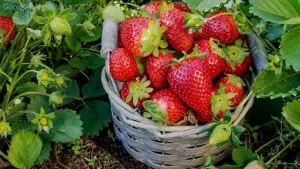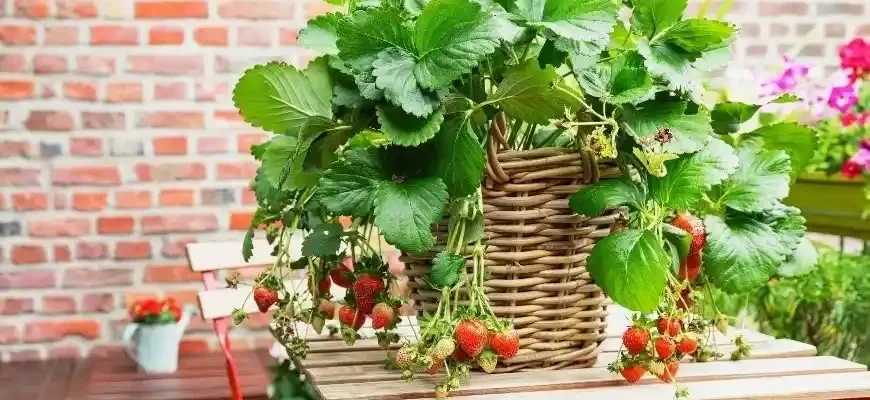Growing strawberries at home is a rewarding and satisfying experience. Whether you’re aiming for fresh, sweet berries in your backyard or a small container garden on a balcony, strawberries are versatile and relatively easy to grow. As someone who’s spent years nurturing strawberries, I can tell you, it’s not only about enjoying the fruits of your labor (pun intended) but also about the joy of watching them grow and thrive.
In this guide, we’ll explore everything from choosing the right strawberry varieties to soil preparation, watering needs, pest control, and harvesting. But, as with any gardening venture, it’s important to know the potential pitfalls, too. I’ll point those out and offer solutions where I can. After all, every plant has its quirks!
1. Choosing the Right Strawberry Variety
When it comes to growing strawberries, selecting the right variety for your climate and growing conditions is crucial. Strawberries are classified into three main types:
- June-Bearing: These varieties produce a large crop of strawberries in early summer. They tend to have higher yields, but you only get one harvest per year.
- Everbearing: These varieties produce fruit in spring, summer, and fall. The yield per season is lower than June-bearing, but the harvest period is extended.
- Day-Neutral: These are the most versatile varieties. They produce fruit throughout the growing season, as long as the temperatures are between 35°F and 85°F (1.5°C to 29.5°C). They’re perfect for growing in containers or small spaces.
Tip: If you’re in a warmer climate, choose everbearing or day-neutral varieties. For colder climates, June-bearing varieties will be the best option.
2. Selecting the Growing Site
Strawberries love the sun. In fact, they need at least 6-8 hours of direct sunlight each day to produce sweet, juicy fruit. If you’re growing them in containers, make sure the location gets plenty of sun, even if it’s on a windowsill or balcony.

The soil needs to be well-draining. Strawberries hate soggy feet, so make sure you’re planting them in loose, sandy loam with a pH between 5.5 and 6.8. A soil test is a great idea here to ensure your soil is in optimal condition.
3. Soil Preparation and Planting
Strawberries prefer fertile soil, rich in organic matter. Before planting, I recommend mixing in compost or well-rotted manure to ensure the soil has good structure and nutrients. You can even improve drainage by adding perlite or vermiculite.
Planting Tip: When planting, ensure that the crown of the strawberry (the part where the roots meet the stem) is level with the soil surface. If it’s buried too deep, the plant could rot. If it’s planted too high, the roots may dry out.
4. Watering and Irrigation
Strawberries need consistent moisture, especially when they are flowering and fruiting. However, as I mentioned before, they don’t like their feet wet. The key is to water deeply and evenly, aiming for about 1-1.5 inches of water per week, either through rainfall or irrigation.
In containers, you’ll need to check moisture levels more frequently. You might want to use a drip irrigation system or a soaker hose to ensure the water is distributed evenly and doesn’t splash on the leaves, which could lead to diseases.
5. Fertilization
Strawberries are relatively light feeders, but they do benefit from a bit of fertilizer. When the plants start flowering, you can feed them with a balanced, slow-release fertilizer or one that’s specifically formulated for fruiting plants. Avoid excessive nitrogen, as it can encourage leaf growth at the expense of fruit production.
In the spring, I recommend adding compost or a fertilizer high in phosphorus and potassium to promote healthy flowering and fruiting.

6. Pest and Disease Control
As with all gardening, pests and diseases are part of the game. But don’t worry, there are ways to deal with them without turning your strawberry patch into a battle zone. Here are the most common threats:
- Slugs and Snails: They love strawberries almost as much as we do. Set up barriers like crushed eggshells or diatomaceous earth around your plants to keep them at bay.
- Spider Mites: These tiny pests can make your strawberry leaves look speckled or yellow. Keep an eye on them, and if the infestation gets bad, you might need to spray with insecticidal soap or neem oil.
- Gray Mold: Also known as Botrytis, this fungal disease can affect strawberries, especially in wet conditions. To prevent it, avoid overhead watering and ensure good air circulation around the plants. Remove any infected leaves immediately.
Pro Tip: Mulching with straw can help reduce soil-borne diseases and keep the fruit clean.
7. Harvesting Your Strawberries
One of the most exciting moments in gardening is harvesting your fruit. For June-bearing varieties, the berries will be ready for harvest in late spring or early summer, usually around 4-6 weeks after the plants bloom. For everbearing or day-neutral varieties, you can enjoy fresh strawberries throughout the growing season.
The key is to pick the berries when they’re fully red. If you leave them on the plant too long, they might start to rot or attract pests.
Tip: When harvesting, gently twist the berry off the stem rather than pulling. This reduces the chance of damaging the plant or the fruit.

8. Dealing with Common Problems
As with any gardening endeavor, you’ll encounter challenges. Here are a few common problems and how to handle them:
- Low Yield: If your strawberries aren’t producing much fruit, it could be due to poor pollination, nutrient deficiency, or incorrect watering. Make sure your plants are well-spaced and getting enough sunlight.
- Spindly Plants: If your plants look weak, they might be crowded or stressed. Consider thinning out the runners or dividing the plants to give them more room to grow.
- Small Berries: If your berries are tiny, check if the plants are stressed by drought, poor soil, or pests. Ensure your plants are properly cared for, and they should start producing larger fruit.
9. Strawberry Varieties to Try
Here are a few popular varieties you might want to consider:
- ‘Chandler’: Excellent for both fresh eating and preserves. Produces large, sweet berries.
- ‘Seascape’: Day-neutral variety, great for containers or hanging baskets. It’s a vigorous grower and highly resistant to disease.
- ‘Albion’: Known for its large, firm, and flavorful berries. It’s a popular choice for home gardeners.
10. Conclusion: Why Grow Strawberries at Home?

Growing strawberries at home isn’t just about enjoying the fresh fruit (although that’s a big plus!). It’s also about taking control of your food source, reducing your carbon footprint, and finding peace in the act of nurturing plants. Whether you’re a beginner or a seasoned gardener, strawberry plants are forgiving, rewarding, and, with a little care, they’ll thrive and reward you with delicious berries.
Opinions from Different People on Growing Strawberries:
- John, 53, USA: “I’ve been growing strawberries for years in my backyard. I love the process—watching the plants grow and caring for them. My tip? Don’t forget about mulching! It keeps the weeds down and the berries cleaner.”
- Maria, 38, Spain: “I started growing strawberries on my terrace because I wanted fresh fruit for my smoothies. It’s not always easy, especially with the hot weather here, but I’ve found everbearing varieties work best. They give me berries all year long!”
- Chen, 60, China: “In my village, we’ve been growing strawberries for generations. My biggest piece of advice? Avoid over-watering! The roots will rot if you’re too generous with the hose.”
- Sofia, 26, Brazil: “I’ve got a small balcony garden, and growing strawberries has been a great hobby. They’re not as high-maintenance as I thought. Just watch out for pests! I use organic pesticides to keep them under control.”
- Amina, 45, Egypt: “Growing strawberries in the desert is a challenge, but not impossible. With the right soil amendments and proper irrigation, I’ve had success with day-neutral varieties. I love having fresh berries for breakfast!”
Whether you’re an experienced gardener or a beginner, strawberry growing is an incredibly satisfying and enjoyable venture. Follow these guidelines, and soon you’ll be tasting the fruits of your labor—literally! Happy gardening!









